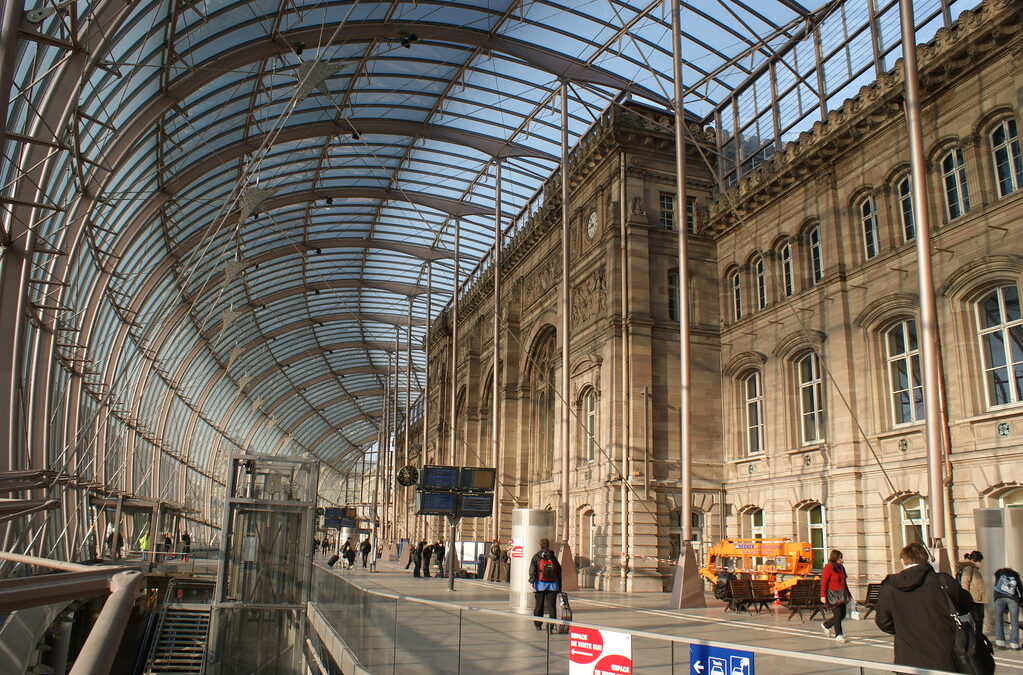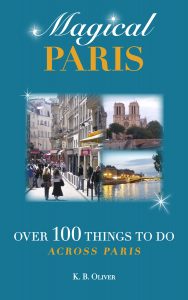FrenchTrain Savvy
Updated 2025
Increase your French Train savvy! This complete and updated post will tell you what you need to know.
Pros and Cons of French Train Travel (Mostly Pros)
Traveling by train in France has many advantages. First, it is the easiest way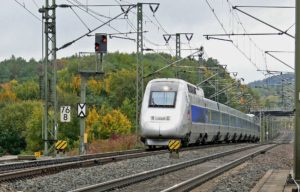 to travel between large cities, and often the fastest. If you rent a car, it takes hours longer than high-speed trains (TGV). Car rental can also cost much more than train travel when you factor in high European gasoline costs and autoroute tolls. And that doesn’t even include driver fatigue (and the need for navigation!)
to travel between large cities, and often the fastest. If you rent a car, it takes hours longer than high-speed trains (TGV). Car rental can also cost much more than train travel when you factor in high European gasoline costs and autoroute tolls. And that doesn’t even include driver fatigue (and the need for navigation!)
The main disadvantage is that you have to follow the train schedules, unlike when you drive, and not all remote places are accessible by train. (Though most of them are, even small villages!)
It’s easier and faster to get to train stations than airports. There are many ways to get discounts on train travel. Some discounts are steep when you order tickets in advance. Lastly, it can be a peaceful and relaxing experience getting where you are going, especially in a comfortable, smooth ride that offers a glimpse of the passing countryside.
Saving Money on French Train Travel
There are three main types of trains in France (see below.) Which one you book depends on the size of your destination, whether a large city or a small town. Previous discounts, like Prems, Loisir, and Pro were retired in 2019. Instead, the SNCF (French national rail company) offers discounts for certain days, as well as the budget OUIGO trains, lower-cost routes that cover large, frequently traveled cities. There is usually one standard class of travel with OUIGO. It’s a no-frills train service with some bag restrictions. You can get some great deals even with last-minute booking on certain routes.
To save money on your TGV ticket (see below), the first tip is to book as far ahead (up to four months) as you can. You’ll have more choices as well. Some tickets will be more expensive simply because of the time of day and day of the week, for example, Friday evenings or Sunday evenings. Weekdays are cheaper, so if you can arrange to travel then, you’ll save money.
Most other trains offer two classes, first and second. As you can imagine, second class is cheaper, though sometimes the difference is very small. There are discounts available for seniors and youth. You’ll save money if you buy a nonrefundable ticket (which is still refundable in the case of a rail strike.) You may still be able to change a ticket that is nonrefundable if you need to.
Types of Trains
Trains Exprès Regionaux (TER): You’ll take TER trains between smaller cities and towns that are closer together within a region (for example, Grenoble to Lyon.) You must buy tickets on the same day of your travel, so there are no pre-booking discounts or assigned seats. The tickets tend to be very inexpensive for short distances and often connect travelers to a central and larger town. Buy tickets at the train station ticket counter or from a self-service ticket machine at the station. There is often a fixed price fare, called “tarif normal.”
Short-distance Intercité: These trains are similar to TER Trains, but are faster than TER trains between cities (and have fewer stops.) They don’t require seat reservations, so you can either buy them the same day or buy them in advance. You can get a discount if you buy it in advance. Some tickets are not refundable. You can reserve these online. These trains might cover routes not covered by TGV trains. Prices may increase closer to departure dates.
TGV and long-distance Intercité: This type of train has a rebranded option called INOUI, with newer trains and more amenities. Regular TGV trains still exist and use the same tracks. Travel times are also the same. (It’s easy to confuse the name INOUI with OUIGO, but they’re quite different. Think high-end vs low-end.)
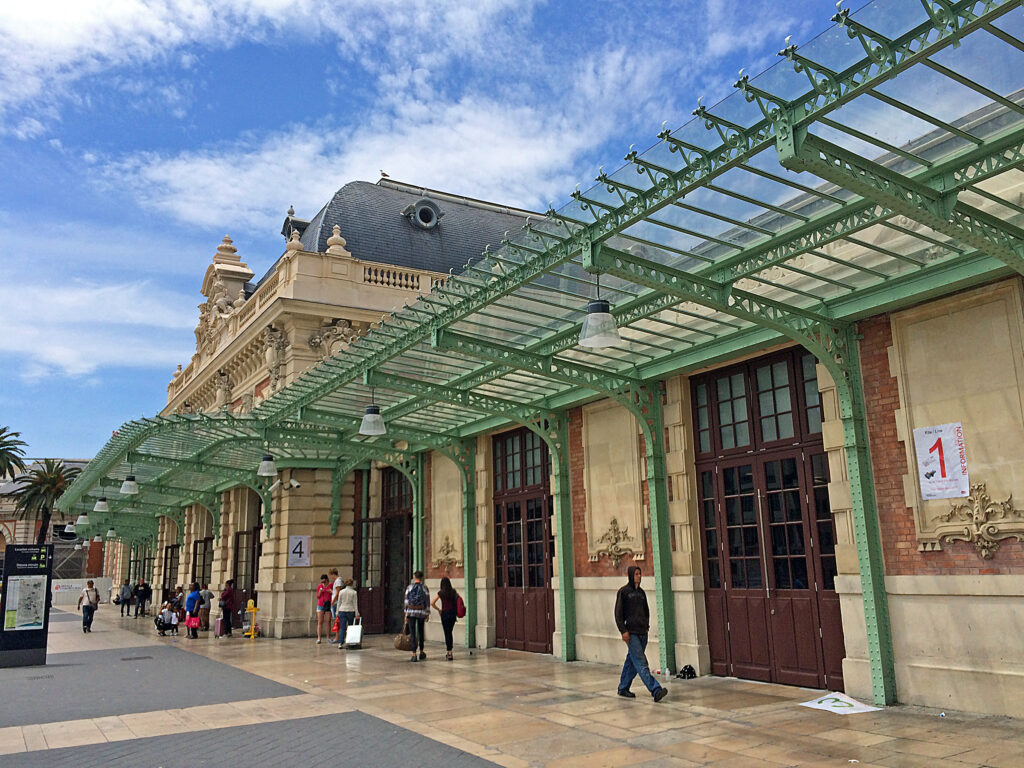
Nice Train station
The TGV train travels at 199 miles per hour, fast enough to travel from Paris to Marseille in under 4 hours. To better appreciate this, it would take 7 hours to travel by car. (Not to mention European gas prices and tolls.) You must have reservations in your name. The price of the reservation is included in your ticket. You’ll have a specific seat assignment, and it will be marked on your ticket. Pre-book for the lowest fares.
SNCF does have a phone app and will store your tickets and information. That’s handy if you like to scan boarding passes from your phone. When it’s time to travel, you will either scan your ticket on the platform or just before you board the train. Hang onto your tickets, because a train employee may pass through again following a stop.
French trains offer power outlets and wifi. For all except OUIGO, a dining car is also provided (normally, train car number four.) In first class, seats are larger, may recline, and sometimes single seats are available. Just like air travel, an increase in flexibility such as ability to change or refund a ticket leads to higher cost.
Where to Buy Tickets
For ticket information, check SNCF-Connect.com, which is the official website for SNCF. Other private companies exist as well, such as Trainline and Rail Europe. www.trainline.eu. You can save money on Trainline by booking 30 days in advance. They offer passes as well as individual tickets and do charge a booking fee, though not on all tickets. For example, you won’t have a fee for a same-day ticket purchased on their app.
Also, Rail Europe is a private company in the UK offering tickets and rail passes for a small booking fee per transaction, not per ticket. They also offer senior and youth discounts.
For OUIGO budget train travel on particular routes, check www.ouigo.com. Ouigo has routes such as between Paris, Lyon, Aix-en-Provence, Avignon, Marseille, Nimes, and Montpellier at discounted prices. Buying directly from SNCF or OUIGO won’t incur any fees. However, if you prefer the ease of the other sites in layout, their small fee might be money well spent. I booked a ticket last spring but ran into a glitch on the SNCF site, so I booked on Rail Europe.
When you buy tickets online, you can print them before you leave. They will also be on your app if you have one, though some routes won’t provide the ticket itself until a few days before your trip. That can be a pain if you’re already traveling by that time. That is when the app is handy to have. You can also get your ticket printed at the station or collect tickets you’ve purchased at the machines.
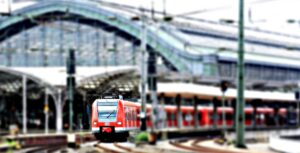
Eurostar Tickets
You can order Eurostar tickets at the Eurostar website, Eurostar.com, with a travel agent, at the SNCF or Trainline website, or at an SNCF station.
Traveling with a Bike
Bikes on the train: Folding bikes or bikes in a bag are generally allowed on most trains. Otherwise, it may require a reservation, depending on the type of train and subject to availability of reserved spaces. You can also consult the following helpful website: http://www.seat61.com/bike-by-train.htm
Other Things to Know
You must validate all tickets before getting on the train, or face a possible fine. You’ll scan your ticket with a rail employee either before you arrive at your platform or just before you board the train.
Smaller trains (and OUIGO) don’t always have dining cars, but you can bring your own snacks or a picnic if you want. TGV trains will usually have dining cars (remember, car number four!)
As you enter the TGV there are racks for luggage at either end of your car. It might not be enough for everyone (but check both ends of the car.) There may also be a rack in the middle of the car. There are additional racks overhead, but they are very small and will only fit a purse or backpack. The best thing is to arrive a bit early and board as soon as you are permitted, so you can find the best place for your belongings.
Train Vocabulary
Quai: train platform
Billet: ticket
Place: seat
Fenêtre: window
Allée or couloir: aisle
Aller-retour: round trip aller-simple: one-way
Un guichet: ticket window (gee-shay)
Le départ: departure l’arrivée: arrival
Voiture de train (or wagon): the train car. For TGV these are numbered, as is your seat
Une gare: the train station
Wagon-restaurant: dining car
Couchette: sleeping car
Bon Voyage!
Related Posts
10-Day Train Tour through Western France
A 10-Day Eastern France Train Tour
Learn French for Travel!
Foundations of Travel French (just the basics)
Real French for Travelers (complete course)


